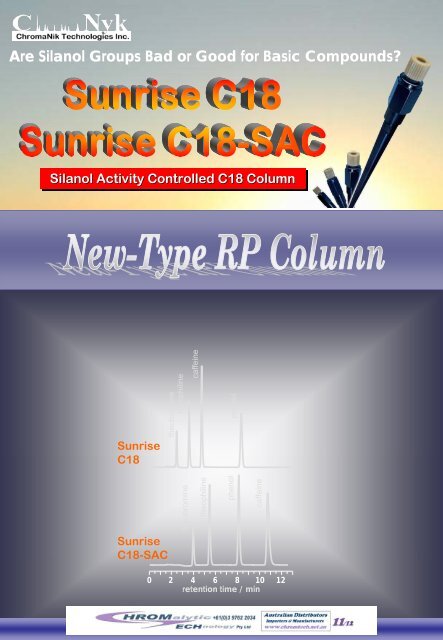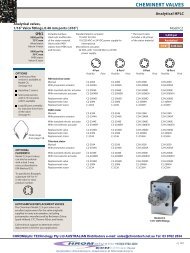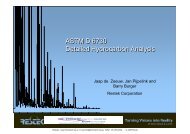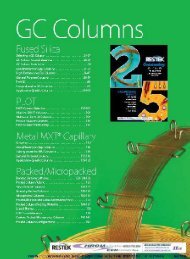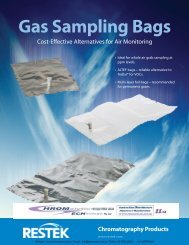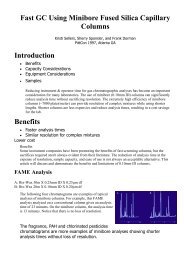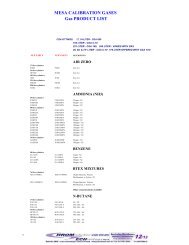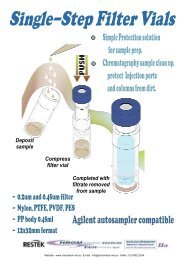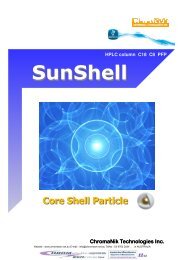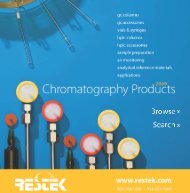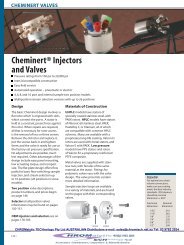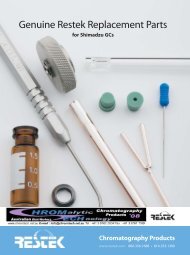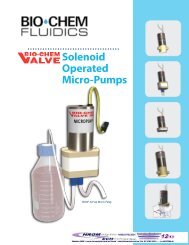Sunrise C18 Sunrise C18-SAC
Sunrise C18 Sunrise C18-SAC
Sunrise C18 Sunrise C18-SAC
Create successful ePaper yourself
Turn your PDF publications into a flip-book with our unique Google optimized e-Paper software.
Are Silanol Groups Bad or Good for Basic Compounds?Silanol Activity Controlled <strong>C18</strong> Column<strong>Sunrise</strong><strong>C18</strong>theobrominetheophilinetheobrominetheophilinephenolcaffeinecaffeinephenol<strong>Sunrise</strong><strong>C18</strong>-<strong>SAC</strong>0 2 4 6 8 10 12retention time / min
<strong>Sunrise</strong> <strong>C18</strong> and <strong>C18</strong>-<strong>SAC</strong>Silanol Activity Controlled <strong>C18</strong> HPLC Column◆ New generation reversed-phase utilized silanol groups■ Silanol group and peak tailingIt is generally said that residual silanol groups ona stationary phase such as <strong>C18</strong> (ODS) causesabsorption or peak tailing for a sample.Especially silanol groups near a hydrophobicsite don’t solvate with water completely, so thatthey show high absorption for basic compounds.Its peak shows terribly tailing. Several endcappingtechniques have been developed tosolve these problems for many years.■ Silanol activity control technology1st generation2nd generationPellicular type3rd generationBonded type4th generationHighly endcappedtypeHigh carbon andend-capped type5th generationHybrid typeSilanol ActivityControlTechnology(Post-X2)<strong>Sunrise</strong> <strong>C18</strong><strong>Sunrise</strong><strong>C18</strong>-<strong>SAC</strong>ChromaNik developed the technique thatdecreased only silanol groups with highabsorption activity to a basic compound andremained effective sailnol groups on thestationary phase. Silanol activity control and noend-capping led the existence of silanol groupswith high hydration which created a new andunique reversed-phase separation modeincluding hydrogen bond and ion-exchangeinteraction. Furthermore, silanol activitycontrolling, then end-capping techniqueimproved a peak shape of a basic compoundexceedingly.OSiOSiOSilanol groupswith highabsorption activitySiHOSiHOSiHSilanol ActivityControlTechnologyOSiSiOSiChangeover tosiloxane bondOSiOSiHSilanol activity control◆ Feature of <strong>Sunrise</strong> series<strong>Sunrise</strong> <strong>C18</strong>•The“1st Choice” column as a fully end-capped <strong>C18</strong> column•Full end-cappingafter silanol activity control•Reducingadsorption of a basic compound extremelyely•A good peak shape for a metal cheleting compoundound•Widely available for general reversed-phaseseparation<strong>Sunrise</strong> <strong>C18</strong>-<strong>SAC</strong>•The "2nd Choice" column which takes advantage ofeffective silanol groups interaction•Reducingsilanol groups with high adsorption activityity•The new separation mechanism including hydrogen bondand ion-exchange interaction•Effective for separation of a basic compound and a polarcompound•Different selectivity and improvement of separation withoutchanging a mobile phase■ The elution order of pyridineA) <strong>Sunrise</strong> <strong>C18</strong>(end-capped)1C) <strong>Sunrise</strong> <strong>C18</strong>-<strong>SAC</strong>(non end-capped)31(2)B) Conventional no end1Column size: 4.6 X 150mm3 Mobile phase:30/70= CH3OH/H2OSample: 1 = uracil(2) = pyridine3 = phenolend-capped<strong>C18</strong>3(2)(2)0 5 10 15 20retention time / min
<strong>Sunrise</strong> <strong>C18</strong> and <strong>C18</strong>-<strong>SAC</strong>Silanol Activity Controlled <strong>C18</strong> HPLC Column◆ <strong>Sunrise</strong> series create an unique separation✻ Effectiveness of silanol activity control: Comparison between <strong>Sunrise</strong><strong>C18</strong> and <strong>C18</strong>-<strong>SAC</strong><strong>Sunrise</strong> <strong>C18</strong> is the so-called fully end-capped <strong>C18</strong>column. It shows the same separation behavior as aconventional <strong>C18</strong> column.On the other hand, <strong>Sunrise</strong> <strong>C18</strong>-<strong>SAC</strong> showshydrogen bond and ion-exchange interactionsbased on a residual silanol on the silica support inaddition to reversed-phase separation. For example<strong>Sunrise</strong> <strong>C18</strong> column separates a basic compoundsimilarly as a conventional <strong>C18</strong>, while <strong>Sunrise</strong> <strong>C18</strong>-<strong>SAC</strong> makes retention of a basic compound belarge because an ion-exchange interaction worksalthough a non-ionic compound shows the almostsame retention on both <strong>Sunrise</strong> <strong>C18</strong> and <strong>C18</strong>-<strong>SAC</strong>.Furthermore, <strong>Sunrise</strong> <strong>C18</strong>-<strong>SAC</strong> shows large retentionfor a polar compound such as caffeine.■ comparison of selectivity for basic compoundsA) <strong>Sunrise</strong> <strong>C18</strong>4321B) <strong>Sunrise</strong> <strong>C18</strong>-<strong>SAC</strong>1 25Column size: 4.6x150 mmMobile phase:50/50=CH 3 CN/20 mM PBS pH4.5Flow rate: 1.0 mL/minTemperature: 40 ºCSample: 1 = uracil2 = propranolol53 = nortriptyline4 = amitriptyline5 = toluene34■ comparison of peak shape and retentionA) <strong>Sunrise</strong> <strong>C18</strong>1B) <strong>Sunrise</strong> <strong>C18</strong>-<strong>SAC</strong>12Column size: 4.6x150 mmMobile phase:10/90=CH 3 CN/20mM H 3 PO 4Flow rate: 1.0 mL/minSample: 1 = 8-quinolinol (oxine)2 = caffeine20 5 10 15 20retention time / min0 2 4 6 8 10 12 14 16 18 20 22retention time / min✻ <strong>C18</strong> with both silanol activity control and full end-capping is effective inseparation of polar compounds.<strong>Sunrise</strong> <strong>C18</strong> is bonded with octadecylsilane on puresilica gel (average pore size: 12nm, specific surfacearea: 340m 2 /g), and end-capped after silanolactivity control. Final carbon content of <strong>Sunrise</strong> <strong>C18</strong>is 15%.Ligand density of <strong>Sunrise</strong> <strong>C18</strong> is intentionally ratherlow and uniformity of ligands is high, so that it showsenough retention, even if a mobile phase with alow organic solvent content is used, and goodpeak shape for a polar compound.■ Separation of organic acid (<strong>Sunrise</strong> <strong>C18</strong>)■ Separation of nucleic acid bases (<strong>Sunrise</strong> <strong>C18</strong>)1 23Column size: 4.6x150 mmMobile phase:2/98=CH 3 CN/0.1% phosphoric acidFlow rate: 1.0 mL/minTemperature: 40 °CSample:1 = formic acid2 = acetic acid3 = propionic acid12Column size: 4.6x150 mmMobile phase: 20mM PBS (pH4.5)Flow rate: 1.0 mL/minTemperature: 40 °CSample:3 1 = cytosine42 = uracil3 = thymidine4 = thymine0 1 2 3 4 5 6 7 8 9 10 11 12 0 1 2 3 4 5 6 7 8 9retention time / minretention time / min
<strong>Sunrise</strong> <strong>C18</strong> and <strong>C18</strong>-<strong>SAC</strong>Silanol Activity Controlled <strong>C18</strong> HPLC Column◆ Multiple mode separation is achieved on <strong>Sunrise</strong> series✻ Silanol groups controlled its activity functions as ion-exchange groups■ Relationship between buffer concentration andretention(<strong>Sunrise</strong><strong>C18</strong>-<strong>SAC</strong><strong>SAC</strong>)log k<strong>Sunrise</strong> <strong>C18</strong>-<strong>SAC</strong> is bonded with octadecylsilane ona pure silica gel and controlled its silanol activitywithout end-capping. Its carbon content is 14%.1.41.21.00.80.60.40.20.0toluene0.5 1.0 1.5 2.0 2.5 3.0log [buffer concentration]N (amitriptyline)amitriptylinenortriptylinepropranolol14,00012,00010,0008,0006,0004,0002,000zBzBVrlog k =− log[ A] + log[ A] + log + 1 log Kz zV zAAA:ion in eluent,B:ion of sample, k:retention of B,K:selectioncoefficientZA, ZB:charge,Vr, Vm:resin volume and mobile phase volume in columnmA0N [amitriptyline]BASeparation on <strong>Sunrise</strong> <strong>C18</strong>-<strong>SAC</strong> is done includinghydrogen bond and ion-exchange interactionbased on silanol groups except for hydrophobicinteraction. Control of pH and salt concentration ofa mobile phase can regulate retention.■ Separation of basic compounds with ammoniumacetate: Effect of salt concentration(<strong>Sunrise</strong><strong>C18</strong>-<strong>SAC</strong><strong>SAC</strong>)200mM100mM50mM25mM10mM1 21111 22323234435453Column size: 4.6x150 mmMobile phase: 70/30=CH 3 CN/acetate buffer (pH4.1)Flow rate: 1.0 mL/minTemperature: 40 °CSample:1 = uracil2 = toluene3 = propranolol4 = nortriptyline5 = amitriptyline50 2 4 6 8 10 12 14 16 18 20 22 24 26retention time / min4455Ordering infomationInnerdiameterlength <strong>Sunrise</strong> <strong>C18</strong>, 5μm <strong>Sunrise</strong> <strong>C18</strong>, 3μm <strong>Sunrise</strong> <strong>C18</strong>-<strong>SAC</strong>, 5μm <strong>Sunrise</strong> <strong>C18</strong>-<strong>SAC</strong>, 3μm[mm]2.0[mm]50Cat. No.SB3241Cat. No.SB2241Cat. No.SA3241Cat. No.SA224175 - SB2251 - SA2251100 SB3261 SB2261SA3261SA2261150 SB3271 SB2271SA3271SA22714.6 10 SB3411 SB2411 SA3411 SA241150 SB3441 SB2441SA3441SA244175 - SB2451 - SA2451100 SB3461 SB2461SA3461SA2461150 SB3471 SB2471SA3471SA2471250 SB3481 -SA3481-10.0 250 SB3781 - SA3781 -20.0 250 SB3881 - SA3881 -


